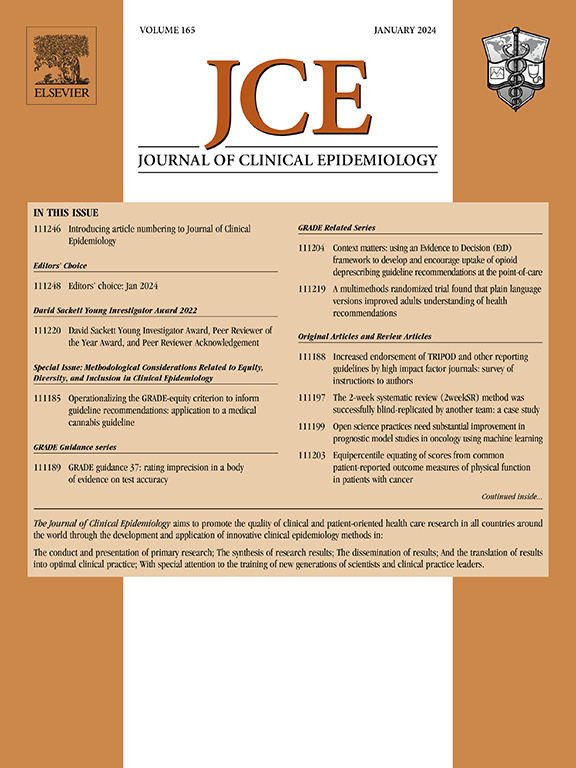Incomplete reporting of adverse events in duloxetine trials: a meta-research survey of randomized controlled trials vs placebo
IF 7.3
2区 医学
Q1 HEALTH CARE SCIENCES & SERVICES
引用次数: 0
Abstract
Background and Objectives
Relying on published data alone might be insufficient for meta-analyses to be reliable and trustworthy since selective outcome reporting is common, especially for adverse events (AEs). We investigated the existence of selective reporting and its potential for bias in a case study exploring AEs of duloxetine in adults.
Study Design and Setting
We systematically searched all previous meta-analyses/pooled analyses on duloxetine published on PubMed for seven indications approved by the American and European health authorities. We included all randomized controlled trials (RCTs) vs placebo. For each RCT, we extracted the number of serious adverse events (SAEs), AEs, drop-outs (DOs) and drop-outs for safety reasons (DOSRs) using four information sources: published articles, clinical study registries, clinical study reports and data available in meta-analyses/pooled analyses. To assess the range of differences resulting from these four extraction strategies, we performed 4 meta-analyses using random effect models as well as a complete meta-analysis combining all sources.
Results
A total of 70 RCTs (including 24,330 patients) were included. Of those, SAEs were identified for 42 studies (61%) in published articles, 58 (84%) in study reports (8 study reports were not retrieved), 24 (34.7%) in registries, and 21 (30.4%) in meta-analyses/pooled analyses. For 2 (2.9%), 2 (2.9%), 2 (2.9%) and 1 (1.4%) studies, we found respectively no data on SAEs, AEs, DOs, and DOSRs in any sources. Discrepant results across sources were found in 24 (34.5%), 20 (28.5%), 13 (18.6%), and 9 (12.8%) studies, respectively for SAEs, AEs, DOs, and DOSRs. Despite variations in point estimates and their 95% confidence intervals, we did not find different results in the conclusions of meta-analyses depending on the different information sources used, except for DOs, for which no effect was found using results published in registries, in contrast to other information sources.
Conclusion
None of the four information sources provided complete retrieval of safety results for duloxetine in adults across various indications. However, we did not find strong evidence that this underreporting leads to different conclusions in meta-analyses. Nonetheless, this finding remains uncertain, as we were unable to obtain complete information for all studies despite extensive searches.
度洛西汀试验中不良事件的不完整报告:随机对照试验与安慰剂的荟萃研究调查。
目的:仅依靠已发表的数据可能不足以使meta分析可靠和可信,因为选择性结果报告是常见的,特别是对于不良事件。我们在一项研究成人度洛西汀不良事件的病例研究中调查了选择性报告的存在及其潜在的偏倚。研究设计和背景:我们系统地检索了美国和欧洲卫生当局批准的7种适应症的PubMed上发表的所有关于度洛西汀的meta分析/汇总分析。我们纳入了所有随机对照试验(RCT)和安慰剂对照试验。对于每一项RCT,我们使用4种信息来源提取严重不良事件(SAE)、不良事件(AE)、退出事件(DO)和因安全原因退出事件(DOSR)的数量:已发表的文章、临床研究登记、临床研究报告和荟萃分析/汇总分析中的数据。为了评估这4种提取策略产生的差异范围,我们使用随机效应模型进行了4次荟萃分析,并结合所有来源进行了一次完整的荟萃分析。结果:纳入70项随机对照试验(rct),共纳入24330例患者。其中,在已发表的文章中发现了42项研究(61%),在研究报告中发现了58项研究(84%)(未检索到8项研究报告),在登记中发现了24项研究(34.7%),在荟萃分析/汇总分析中发现了21项研究(30.4%)。在2项(2.9%)、2项(2.9%)、2项(2.9%)和1项(1.4%)研究中,我们分别没有发现任何来源的sae、ae、DOs和DOSRs的数据。在SAEs、ae、DOs和DOSRs方面,不同来源的研究结果分别有24项(34.5%)、20项(28.5%)、13项(18.6%)和9项(12.8%)。尽管点估计值及其95%置信区间存在差异,但我们在meta分析的结论中没有发现不同的结果,这取决于所使用的不同信息源,除了DOs,与其他信息源相比,在注册表中发表的结果没有发现任何影响。结论:四个信息来源中没有一个提供完整检索度洛西汀在成人各种适应症的安全性结果。然而,我们没有发现强有力的证据表明,在荟萃分析中,这种低报导致了不同的结论。尽管如此,这一发现仍然不确定,因为尽管进行了广泛的搜索,我们仍无法获得所有研究的完整信息。
本文章由计算机程序翻译,如有差异,请以英文原文为准。
求助全文
约1分钟内获得全文
求助全文
来源期刊

Journal of Clinical Epidemiology
医学-公共卫生、环境卫生与职业卫生
CiteScore
12.00
自引率
6.90%
发文量
320
审稿时长
44 days
期刊介绍:
The Journal of Clinical Epidemiology strives to enhance the quality of clinical and patient-oriented healthcare research by advancing and applying innovative methods in conducting, presenting, synthesizing, disseminating, and translating research results into optimal clinical practice. Special emphasis is placed on training new generations of scientists and clinical practice leaders.
 求助内容:
求助内容: 应助结果提醒方式:
应助结果提醒方式:


